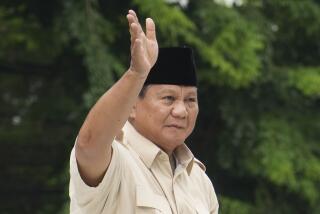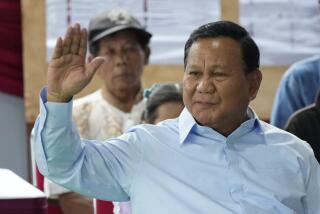With Suharto Gone, Media Come to Life
- Share via
JAKARTA, Indonesia — To gauge how much Indonesia has changed since President Suharto was swept from power in May, you need only see the hordes of raggedy boys who descend on motorists stuck in Jakarta’s bumper-to-bumper traffic.
Unlike the scenes in some Asian capitals, the boys are not peddling chewing gum or offering shoeshines. They are selling newspapers and magazines. Dozens of them. So many that they have trouble displaying all the different publications available.
The message is clear: After enduring 32 years of Suharto’s stern rule, Indonesia’s media are freer. Along with those in Thailand and the Philippines, the media here have become among the liveliest, least restricted and most aggressive in Southeast Asia.
Since Suharto’s political demise, 370 new publications, including nine weekly newsmagazines and myriad tabloids, have rolled off the presses. Virtually no topic from sex to politics, except perhaps the depth of the military’s business interests, is off limits to the new breed of feisty journalists.
“We’re not there yet, but I think in time we can achieve a truly free press in Indonesia,” said Eko Maryadi, 30, who spent two years in jail for violating Suharto’s vague law that journalists must write “responsibly.”
“Right now everything is so new people are still afraid to talk openly,” Maryadi said, “but the debate in the press is helping overcome those fears.”
During the final years of Suharto’s reign, at least 30 publications were closed for offending the authorities. Editors were told whose picture to put on Page One. Anyone wanting to start a publication needed to be licensed by the government--a privilege involving large bribes--and usually had to include the minister of information as a shareholder.
But Suharto’s successor, President B.J. Habibie, has made good on his promise to lift media restrictions; getting a license is no longer necessary. His minister of information, Lt. Gen. Mohammed Yunus, once the uncompromising director of security in the East Timor region, has startled everyone by becoming a born-again advocate of a free press.
Of all the publications now on the streets, none is a more welcome sight to most Indonesians than Tempo. The respected Indonesian-language weekly newsmagazine introduced the country to investigative journalism, then was shut down in 1994.
Its closure sparked street protests and transformed its editor in chief, Goenawan Mohammed, into a popular political activist. Mohammed, 57, was one of five recipients of the International Press Freedom Awards given last month in New York by the Committee to Protect Journalists.
Mohammed, a distinguished novelist and poet, was never told why Tempo lost its license, but its last cover story--on the government’s foolhardy purchase of 39 secondhand warships once owned by East Germany--was a likely cause. Habibie, who was then the minister of research and technology, approved the purchase.
In its first cover story upon returning last month, Tempo went after another equally sensitive topic: the rape of ethnic Chinese during the May riots that helped bring down the Suharto government. The press run was 120,000, down from a peak of 200,000 in 1994. But the magazine sold more advertising than it could handle, despite Indonesia’s economic downturn.
“If we’d had a free press all the along,” said Santoso, former secretary-general of the Alliance of Independent Journalists, “the problems we have today with corruption, nepotism, the economy would not have been allowed to accumulate. They would have been exposed, debated and acted on.”
Indonesia’s experiment with a free press is not something that is applauded by all governments in Southeast Asia. Some national leaders believe that the region’s turbulent economic and political times would be all the more dangerous if people had access to a free flow of critical information.
More to Read
Sign up for Essential California
The most important California stories and recommendations in your inbox every morning.
You may occasionally receive promotional content from the Los Angeles Times.












